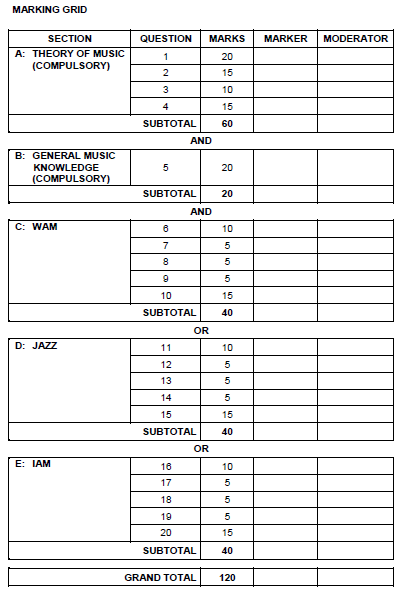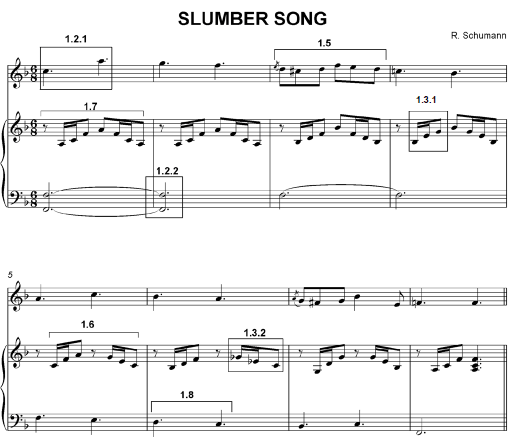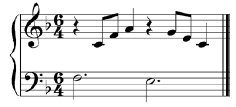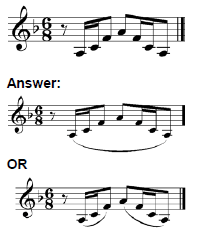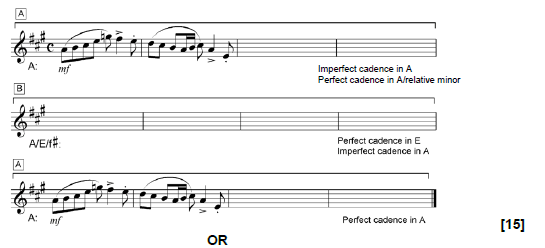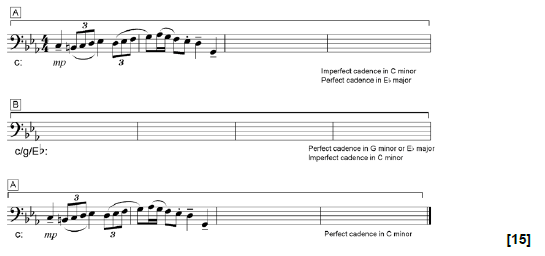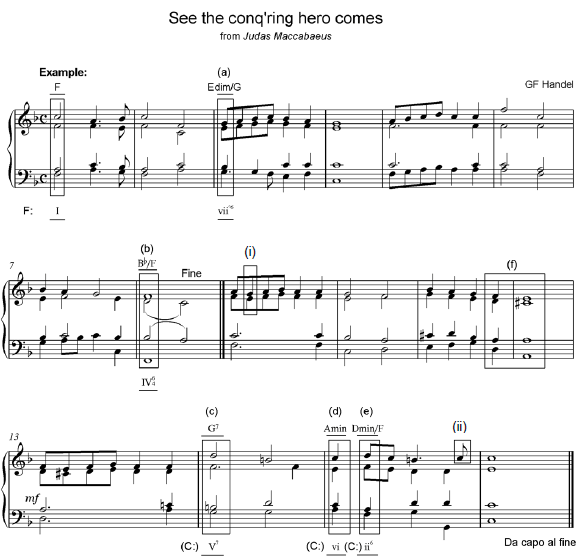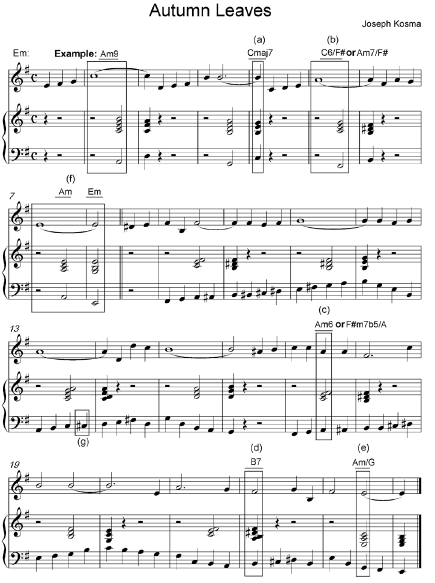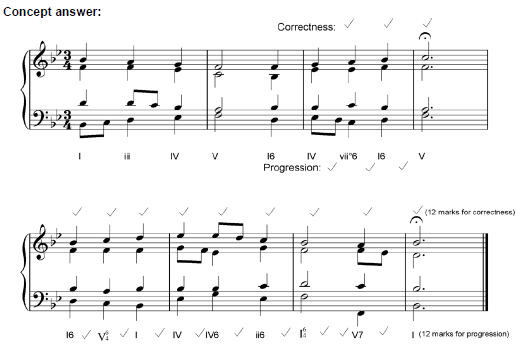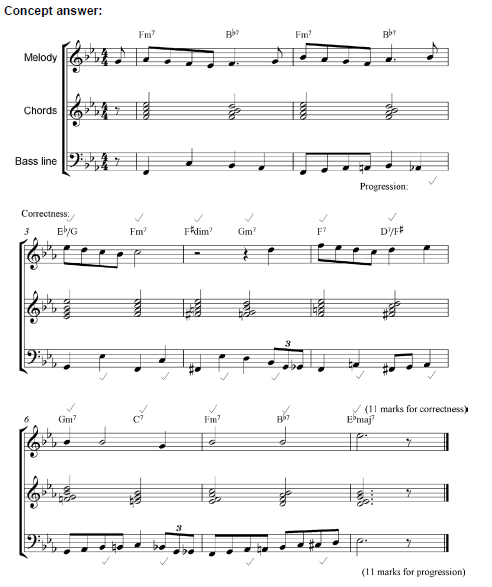MUSIC P1 Past Paper FEBRUARY/MARCH 2016 Memo/Memorandum - GRADE 12 NATIONAL SENIOR CERTIFICATE
Share via Whatsapp Join our WhatsApp Group Join our Telegram GroupMUSIC P1
FEBRUARY/MARCH 2016
MEMORANDUM
INSTRUCTIONS AND INFORMATION
- This question paper consists of FIVE sections, namely SECTIONS A, B, C, D and E.
- SECTIONS A and B are compulsory.
- SECTION C: WESTERN ART MUSIC (WAM), SECTION D: JAZZ and SECTION E: INDIGENOUS AFRICAN MUSIC (IAM) are choice questions. Answer only ONE of these sections (SECTION C or D or E).
- Write all music notation in SECTION A in pencil and all written text in blue or black ink on this question paper.
- Answer SECTION B and SECTION C or D or E in blue or black ink in the ANSWER BOOK provided.
- Number the questions correctly according to the numbering system used in this question paper.
- The last page of this question paper is manuscript paper intended for rough work. Candidates may remove this page.
- Candidates may NOT have access to any musical instrument for the duration of this examination.
- Write neatly and legibly.
SECTION A: THEORY OF MUSIC (COMPULSORY) (90 minutes)
Answer QUESTION 1
AND QUESTION 2.1 OR 2.2
AND QUESTION 3.1 OR 3.2
AND QUESTION 4.1 OR 4.2.
Candidates must answer the questions in the spaces provided on this question paper.
QUESTION 1 (25 minutes)
Study the score below and answer the questions that follow.
1.1 Name the key of this extract.
Answer:
F major
| F major = 1 mark (1) |
1.2 Name the intervals at 1.2.1 and 1.2.2 according to type and distance.
Answer:
1.2.1 Major 6th
1.2.2 Perfect 8th (octave)
| 1.2.1 Major 6th = 1 mark 1.2.2 Perfect 8th (octave) = 1 mark |
| No mark for 6th or 8th alone) |
(2)
1.3 Name the type of triad at 1.3.1 and 1.3.2, for example minor triad. (Consider only the notes in the block on the score.)
Answer:
1.3.1 Diminished triad
1.3.2 Diminished triad
| 1.3.1 Diminished triad = 1 mark 1.3.2 Diminished triad = 1 mark |
(2)
1.4 Circle a chord that forms a dominant seventh chord in root position on this score.
Answer:
Bar 72 (CEGBb)
| Correct answer (bar 72) = 1 mark |
(1)
1.5 Transpose bar 3 of the solo part a minor third lower for the E-flat alto saxophone. Add a new key signature.
Answer:
| Correct key signature =1 mark |
| 1 mark per beat = 2 marks |
| Time signature is optional = no mark |
(3)
1.6
Transcribe bar 5 of the piano part (right hand) for viola at the same pitch. Use the correct clef.
Answer:
| Correct clef = 1 mark |
| 1 mark per beat = 2 marks |
| Minus ½ mark per mistake to a maximum of 2 marks |
| Time signature is optional = no mark |
(3)
1.7 Rewrite bar 1 of the piano part (right hand), but halve the note values. Add a new time signature.
Answer:
| Correct time signature = 1 mark |
| 1 mark per beat = 2 marks |
| Minus ½ mark per mistake to a maximum of 2 marks |
(3)
1.8 Complete the following to form a pentatonic scale:
| 1 mark per bar = 2 marks |
| Minus ½ mark per mistake to a maximum of 2 marks |
(2)
1.9 Write an ascending sequence of the given melodic fragment.
| Sequence = 1 mark |
| Minus ½ mark if the sequence itself is correct, but the placing is descending |
| Minus ½ mark per mistake to a maximum of 1 mark |
(1)
1.10 Compare the music example below with the piano part in bar 5. Which compositional technique is used in the example below?
Answer:
(Rhythmic) Augmentation or doubling the note values
| (Rhythmic) Augmentation or doubling the note values = 1 mark |
(1)
1.11 Add a performance indication(s) to the extract below to instruct the performer to play legato.
| Correct performance indication = 1 mark | |
| 'Ped...' may be written below OR 'Legato' or 'leg.' May be written below | = 1 mark = 1 mark |
(1)
[20]
QUESTION 2 (25 minutes)
Answer EITHER QUESTION 2.1 OR QUESTION 2.2.
2.1
Complete the opening motif below to form a twelve-bar melody in ternary form for any single-line melodic instrument of your choice. Name the instrument for which you are writing. Indicate the tempo and add dynamic and articulation marks.
Concept answer:
Instrument: Guitar/Saxophone/Clarinet/Trumpet
OR
2.2
Complete the opening motif below to form a twelve-bar melody in ternary form for any single-line melodic instrument of your choice. Name the instrument for which you are writing. Indicate the tempo and add dynamic and articulation marks.
Concept answer:
Instrument: Trombone/Bassoon/Cello
The melody will be marked according to the following criteria:
| DESCRIPTION | MARK ALLOCATION | CANDIDATE'S MARKS | ||
| Form and cadential points | 1 mark per phrase x 3 | 3 | ||
| Correctness Note stems, beats per bar, accidentals, spacing, layout | Minus ½ mark per error up to 2 marks | 2 | ||
| Quality- Quality of melody and suitability for chosen instrument- Appropriate dynamic and articulation indications- Musicality | 9–10 | Excellent Coherent and musical; cadences imaginatively define the form; opening motif innovatively continued; ingenious use of tonality is successful; melodic shape masterfully handled; creative approach to choice of pitches and rhythm | 10 | |
| 7–8 | Good Correct and musical; cadences clearly indicate the form; opening motif sensibly continued; stable tonality; modulation (not compulsory) is attempted; melodic shape satisfying; choice of pitches and rhythm accurate | |||
| 4–6 | Average Musically not convincing; not all cadences clear; opening motif not well utilised; choice of pitches and rhythm unimaginative | |||
| 1–3 | Not acceptable No musical sense; no sense of cadence; opening motif ignored; no sense of tonal centre; no melodic shape; pitches and rhythm random | |||
| TOTAL | Markers may use ½ marks | 15 | ||
QUESTION 3 (10 minutes)
Answer EITHER QUESTION 3.1 OR QUESTION 3.2.
3.1 Study the score below and answer the questions that follow.
Answer:
3.1.1 This piece modulates in bars 11–133. Name the new key.
Answer:
D minor
| D minor = 1 mark |
(1)
3.1.2 A second modulation occurs in bars 14–16. How is the new key in these bars related to F major?
Answer:
Dominant (major)/V of F major/I
| Dominant (major)/V = 1 mark |
(1)
3.1.3 Identify the chords from (a)–(e) and figure them on the score. Use EITHER figuring symbols below the score OR chord symbols above the score. (Note the example in bar 1.)
Answer:
See score:
| 1 mark per chord = 5 marks (minus ½ mark for each error) Alternative figuring symbols, e.g. Va,Vb,Vc will also be acceptable. |
(5)
3.1.4 Name the cadence at (f).
Answer:
Imperfect/Incomplete (cadence)
| Imperfect/Incomplete (cadence) = 1 mark |
(1)
3.1.5 Name the type of non-chordal notes at (i) and (ii).
Answer:
(i) (Lower) Auxiliary note
(ii) Anticipation
| (i) (Lower) Auxiliary note= 1 mark (ii) Anticipation = 1 mark |
| No ½ marks |
(2)
[10]
OR
3.2 Study the score below and answer the questions that follow.
3.2.1 This piece modulates in bars 122–162. Name the new key.
Answer:
G major
| G major = 1 mark |
(1)
3.2.2
Identify the chords from (a)–(e) and write chord symbols above the score. (Note the example in bar 1.)
Answer:
See score:
| 1 mark per chord = 5 marks (minus ½ mark for each error) Roman numerals will not be accepted |
(5)
3.2.3 Write the chord progression and the name of the cadence at (f).
Answer:
- Am – Em or iv-i
- Plagal (cadence)
| Am – Em = 1 mark (½ mark for each correct chord) Plagal (cadence) = 1 mark |
(2)
3.2.4 Name the type of non-chordal note at (g).
Answer:
(g) (Chromatic) Passing note
| (Chromatic) Passing note = 1 mark |
(1)
3.2.5 Name the stylistic feature used in the bass clef from bars 9–24.
Answer:
Walking bass (line)
OR
Continuous movement of the bass in crotchets
| Any correct answer = 1 mark |
(1) [10]
QUESTION 4 (30 minutes)
Answer EITHER QUESTION 4.1 OR QUESTION 4.2.
4.1
Complete the four-part vocal harmonisation below by adding the alto, tenor and bass parts. Use at least TWO non-chordal notes.
The harmonisation will be marked according to the following criteria:
| DESCRIPTION | MARK ALLOCATION | CANDIDATE'S MARK | |
| Chord progression Choice of chords, correct use of cadence | 1 mark between each pair of chords | 12 | |
| Correctness Notation, doubling, spacing, voice leading | Minus ½ mark per error but not more than minus 1 mark per chord = 12 chords from bar 32–81. | 12 | |
| Quality Bass line, musicality, non-chordal notes, awareness of style, innovation, creativity |
| 16 | |
| Note to marker: Mark out of 40 must not contain a ½ mark | 40÷8 x 3 | ||
| TOTAL | 15 | ||
Candidates must be credited for a different/creative and correct harmonisation not given in the memorandum.
The figuring symbols serve as a guide for the marker, but no marks are allocated for the symbol as such.
[15]
OR
4.2
Complete the piece below by adding a suitable bass line and harmonic material in the incomplete bars. Continue in the style suggested by the given material in bars 1 and 2 and add the chord symbols above the melodic line.
The harmonisation will be marked according to the following criteria:
| DESCRIPTION | MARK ALLOCATION | CANDIDATE'S MARK | |
| Chord progression Choice of chords, correct use of cadences | 1 mark between each pair of chords from the end of bar 2–8 = 11 progressions (chord symbols and notation must correspond) | 11 | |
| Correctness Notation, spacing, voice leading | Minus ½ mark per error but not more than 1 mark per chord = 11 chords (two chords per bar (3–7) and one in bar 8) | 11 | |
| Quality Musicality, non-chordal notes, awareness of style, innovation, creativity |
| 18 | |
| Note to marker: Mark out of 40 must not contain a ½ mark | 40÷8 x 3 | ||
| TOTAL | 15 | ||
Candidates must be credited for an alternative/creative and correct harmonisation not given in the memorandum.
The figuring symbols serve as a guide for the marker, but no marks are allocated for the symbol as such.
[15]
TOTAL SECTION A: 60
SECTIONS B, C, D, E: GENERAL MUSIC KNOWLEDGE (90 minutes)
Answer SECTION B
AND SECTION C (Western Art Music)
OR SECTION D (Jazz)
OR SECTION E (Indigenous African Music).
Candidates must answer these questions in the ANSWER BOOK provided.
| One mark will be allocated for each correct fact. Candidates must be credited for any other correct answer not given in the memorandum. |
SECTION B: GENERAL (COMPULSORY)
QUESTION 5
5.1
5.1.1 C
5.1.2 B
5.1.3 A
5.1.4 C
5.1.5 C
5.1.6 A
5.1.7 D
5.1.8 D
5.1.9 D
5.1.10 B
| One mark per answer = 10 marks |
(10)
5.2
5.2.1 RUBATO
- In performance the variation of pulse by subtle lengthening and shortening of notes
Essential fact = 1 mark - Expressive changes to the position of beats within a bar
- Flexibility of pulse by accelerating and slowing down the tempo
(2)Any other fact = 1 mark
5.2.2 LIBRETTO
- Text of an opera or oratorio
Essential fact = 1 mark - List the cast of characters
- May give a summary of the plot or background information
- Often gives stage directions and a description of scenes
(2)Any other fact = 1 mark
5.2.3 SCATTING
- Singing style in jazz using non-sense syllables instead of words
Essential fact = 1 mark - Improvisational vocal jazz solo
- Includes sounds like yodels or percussive sounds
Any other fact = 1 mark
5.2.4 SUBSTITUTION CHORD
- A chord that is substituted for another chord
Essential fact = 1 mark - Used for harmonic variation or sound effects
- Change in bass line and voice leading without change in overall chord function (2)
Any other fact = 1 mark
5.2.5 MELORHYTHM
- High/low tones (pitch variations) on one drum
Essential fact = 1 mark - Drum technique
- 'Melodic rhythms' used in drum playing
Any other fact = 1 mark
5.2.6 UKUVAMBA
- Maskandi guitar style
Essential fact = 1 mark - Used in isiZulu culture
- Strumming of chords (vamping) (2)
Any other fact = 1 mark
(2 x 2) (4)Note to marker: Mark only the first two terms if more than two were answered.
5.3
- Copyrights
- Production rights
- Distribution rights
- Performance rights
- Editorial rights (e.g. adding new lyrics to the original work)
- Marketing rights
- Selling rights
| Any SIX correct facts = 1 mark each = 4 marks |
(6)
TOTAL SECTION B: 20
Answer SECTION C (WAM)
OR SECTION D (JAZZ)
OR SECTION E (IAM).
Note to marker: Any correct answer that does not appear in this memorandum will also be accepted.
SECTION C: WESTERN ART MUSIC (WAM)
QUESTION 6
6.1
6.1.1 Sonata
6.1.2 Allegro ma non troppo
6.1.3 The Storm
6.1.4 Allegro
6.1.5 Shepherd's song; cheerful and thankful feelings after a storm
6.1.6 Sonata Rondo
| One mark per answer = 6 marks The word 'fast' is not acceptable instead of 'Allegro' |
(6)
6.2 Piccolo
| Piccolo = 1 mark |
(1)
6.3
- The third movement leads directly into the fourth movement with only an imperfect cadence between the movements
- There is no pause between the fourth and fifth movements
(1)Any correct fact = 1 mark
6.4
6.4.1 First movement
6.4.2 Fifth movement
| One mark each = 2 marks |
(2)
[10]
QUESTION 7
7.1 Hebrides Overture
| Hebrides Overture = 1 mark |
(1)
7.2 Sonata form
| Sonata form = 1 mark |
(1)
7.3
- Mendelssohn visited the Hebrides Islands
- Impressed and inspired by the stark natural beauty
- Heard stories about the echoes in the cave
- Wrote to his sister about his experiences on the island
- Made water colour paintings of the sea and the sky
(3)One mark for each fact = 3 marks
[5]
QUESTION 8
Similarities
- One movement
- Orchestral work
- Both can be performed independently
One mark per fact, per genre = 2 marks
Differences
Overture
- Introduction to an opera, ballet or stage play
- Often sets the scene or is based on material from the opera
Concert Overture
- An independent work
- Often programmatic in nature (inspired by literature, nature, etc.)
Any three related facts
= 3 marks
[5]
QUESTION 9
- The layout of the standard classical orchestra into four groups was established, e.g.:
- Strings: Violin 1, Violin II, Viola, Violoncello, Double bass
- Woodwinds: 2 Flutes, 2 Oboes, 2 Bassoons (Clarinet as solo instrument but not in orchestra)
- Brass: 2 Horns
- Percussion: 2 TimpaniAny two facts = 2 marks - Playing and performance techniques developed, e.g. use of
- Tremolo
- Sudden sfz
- Opening arpeggios
- Crescendo and decrescendo
- 'Rocket' motif
- Dynamics
- 'Sigh' motifAny two facts = 2 marks - Established sonata form
- Development of the Symphony structure: Fast/Slow/Minuet and Trio/Fast
Any fact = 1 mark
[5]
QUESTION 10
Comic Elements represented by Papageno's aria:
Der Vogelfänger bin ich ja
- Character: Papageno – provides comic relief in opera 1 mark
- Voice type: Baritone 1 mark
- Characterisation of story through music:
- Melody: - simple, playful folk-like melody
- the orchestra sets the playful mood - Key: major - happy mood
- Rhythm/Tempo: moderate (Andante) steady pulse in 2/4 (simple time)
- Articulation: light orchestration with extensive use of staccato
- Harmony: Classical tonal harmony, simple and sunny
- Text: cheeky character of Papageno's life and loves
- Vocal character: light and playful 4 marks
- Melody: - simple, playful folk-like melody
Serious Elements represented by the Queen of the Night's aria:
Die Hölle Rache kocht in meinem Herzen
- Character: Queen of the Night – provides dramatic impulse in opera 1 mark
- Voice type: Soprano (coloratura) 1 mark
- Characterisation of story through music:
- Melody: theatrical and aggressive melodic passages throughout
- sharp extreme dynamic changes using fp and sf - Key: minor – dark mood
- Rhythm/Tempo: fast tempo contributes to the dramatic feel
- Articulation: fuller orchestration with use of legato, staccato and sudden accents
- Harmony: use of diminished chords heightens the tension
- Text: The Queen of the Night's anger at Tamino's failure
- Vocal character: Extreme vocal range; showcase aria 4 marks
- Melody: theatrical and aggressive melodic passages throughout
Logical presentation and structure = 3 marks
The essay will be marked according to the following criteria:
| DESCRIPTION | MARK ALLOCATION | ||
| Der Vogelfänger bin ich ja | 1 mark for each correct fact | 6 | |
| Die Hölle Rache kocht in meinem Herzen | 1 mark for each correct fact | 6 | |
| Logical presentation and structure | • Excellent • Good • Average • Weak | = 3 marks = 2 marks = 1½ marks = ½ mark | 3 |
| TOTAL | 15 | ||
[15]
TOTAL SECTION C: 40
OR
SECTION D: JAZZ
QUESTION 11
11.1
| COLUMN A | COLUMN B |
| 11.1.1 | A Piano |
| 11.1.2 | E Penny-whistle |
| 11.1.3 | B Saxophone |
| 11.1.4 | C Guitar |
| 11.1.5 | D Voice |
| 1 mark for each correct answer = 4 marks Note to marker: Mark only the first FOUR answers if more than four answers were given. |
(4)
11.2
- The Blue Notes – Chris McGregor
- Manhattan Brothers – Nkosinathi Hadebe
- Sakhile – Sipho Gumede/Khaya Mahlangu
(2)Any TWO correct answers = 2 marks
11.3
- Cheap
- Portable
- Related to the traditional three-holed flute used by cattle herders
- Lends itself to be both a solo and ensemble instrument
- Symbol of resistance against oppression
- Could be used to warn others of the arrival of the police
| Any FOUR correct answers = 4 marks |
(4)
[10]
QUESTION 12
Melody
- Improvisatory in character
- Based on blues and folk songs
- Based on Cape Malay/Khoi-san vocal traditions
Rhythm
- Ghoema beat
- Rhythmic characteristics of amaXhosa music
Instrumentation
- Brass
- Percussion
- Banjo
- Guitar
- Piano
- Bass
- Saxophone
[5]Melody: 1 mark per fact x 2
Rhythm: 1 mark per fact
Instrumentation: any correct fact x 2= 2 marks
= 1 mark
= 2 marks
QUESTION 13
- Mbaqanga
- Fusion of Marabi and Kwela
- Dance-like characteristics with a more powerful sound and harder driving beat than Kwela
- Uses Western instruments: Bass, drums, guitar, vocalist(s), organ, brass, saxophone
- Mix between Western instrumentation and African vocal style
- Usually begins with a short improvised introduction featuring a rhythmic motif on the solo guitar
- Uses a four bar sequence of chords suggested by bass guitar:
I – IV – IC– V or I – IV – V – I - Repetitive rhythmic and melodic ideas found in the vocal lines
- Use of close harmonies in vocal backing
- Call and response is used in the vocal passages
- Call and response is used between voices and instruments
- Call and response occurs between the lead vocalist and backing vocalist(s)
- Lyrics often in the vernacular
- Vocalisations such as crepitations and ululations included
[5]Name of style 'mbaqanga' = 1 mark
Any four correct facts = 4 marks
QUESTION 14
- Increasing urbanisation around mining centres led to the development of slums
- Music reflected the people's way of life
- Centred on beer-brewing, drinking and having a good time
- Marabi dance parties were the weekend centre of community life
- Gave the black community and working class a sense of identity
- Used either the pedal-organ or more often the piano
- Music created the energy for the all night shebeen parties
- Shared common characteristics with American Ragtime, Blues and Jazz
- Music built around the repetitive harmonic cycle I – IV – IC – V – I
- Three-chord pattern for the reworked traditional melodies
- Repetitive single-themed dance tunes
| Any FIVE correct answers = 5 marks |
[5]
QUESTION 15
Zim Nqawana:
History
- Born in Port Elizabeth
- Started playing flute at 21 years of age
- Obtained entrance to Rhodes University
- Enrolled and completed a National Diploma in jazz studies at University of Natal
- Offered scholarship with Wynton Marsalis
- Worked with Hugh Masekela and Abdullah Ibrahim
- In 2004 asked to produce Let Freedom Swing for the Lincoln Center Jazz Orchestra in New York (with Brubeck)
| Any five facts for 5 marks |
Style characteristics
- Rooted in indigenous sounds
- Fuses traditional ancient Xhosa (and other African) rhythms and songs with his interpretation of modern Jazz
- Progressive approach to phrasing and cadence to align with international practices
- Avant-garde approach to music
- Influenced by Abdullah Ibrahim
- Music contained elements e.g. bop, funk, Indian and Western classical music, samba, tango and vocal chants
- Highly percussive and often dance-like
- Strongly improvisatory
- Some music influenced by the folk traditions of Norway
| Any five facts for 5 marks |
Hit/Album
- eBhofolo
| Any two (including ones not mentioned here) for 2 marks |
[15]
OR
Sakhile:
History
- In 1982 Sipho Gumede joined Khaya Mahlangu and Mabe Gabriel Thobejane to form Sakhile
- In 1987 Sakhile was revived, and toured Switzerland, Italy, Britain, Germany and several African countries
- Sakhile represented South Africa at the 'Meeting of the World' music festival in Finland and the Soviet Union
- Before Sipho's death in 2004, the final album Togetherness was released
- Albums got limited radio support
- In 1990 they played as the core musical group for South African performers at the Wembley Mandela tribute
| Any five facts for 5 marks |
Style characteristics
- Traditional African roots
- Use of Western instruments, e.g. electric guitar
- Mixture of jazz and traditional African music
- Has glimpses of township music
- Lyrics depict the political atmosphere of the times
- Mbaqanga guitar style employed
- The sound is commercial
- Malombo influence introduced by the percussionist Mabe Thobejane
- Use of repetitive themes
- Often used traditional dancers during their performances
- Influenced by jazz fusion of Miles Davis
Any five facts for 5 marks
Hit/Album
- Sakhile, Isililo
| Any two (including ones not mentioned here) for 2 marks |
[15]
OR
Spirits Rejoice:
History
- Formed by Gilbert Matthews in 1974
- Original members were trumpeter George Tyefamani, bass player Phillip Tyefamani and guitarist Doc Mnthalane
- Sipho Gumede, Bheki Mseleku, Robbie Jansen, Duke Makasi joined later as replacements
- Band named after Albert Ayler's song of the same name
- Became a pit band for a theatrical project-Black Mikado
- Worked on the Sounds Black stage show with Malombo
| Any five facts for 5 marks |
Style characteristics
- Fuses many styles:
- Jazz and traditional African music
- Free jazz mixed with jazz rock
- Popular music and jazz (pop album and covers)
- American and African jazz
- Latin American and African jazz
- Contains elements of 'smooth jazz' emerging in the 1980s
- Their music was mostly serious by nature, i.e. not dance music
- Often uses repetitive hymn-like themes
| Any five facts for 5 marks |
Hit/Album
- Joy, I'm so strong now
| Any two (including ones not mentioned here) for 2 marks |
[15]
The essay will be marked according to the following criteria:
| DESCRIPTION | MARK ALLOCATION | ||
| History | 1 mark for each correct fact | 5 | |
| Style characteristics | 1 mark for each correct fact | 5 | |
| Two hits/Albums | 1 mark for each | 2 | |
| Logical presentation and structure | • Excellent • Good • Average • Weak | = 3 marks = 2 marks = 1½ marks = ½ mark | 3 |
| TOTAL | 15 | ||
15
TOTAL SECTION D: 40
OR
SECTION E: INDIGENOUS AFRICAN MUSIC (IAM)
QUESTION 16
| COLUMN A | COLUMN B |
| 16.1.1 | I vhaVhenda |
| 16.1.2 | D maXhonga |
| 16.1.3 | E amaXhosa |
| 16.1.4 | H baSotho |
| 16.1.5 | A baPedi |
| 16.1.6 | G baTswana |
| 16.1.7 | F amaNdebele |
| 16.1.8 | B amaSwati |
| 16.1.9 | C amaZulu |
| 1 mark for each correct answer = 4 marks Note to marker: Mark only the first FOUR answers if more than four answers were given. |
(4)
16.2
- Adding excitement to the performance
- To show approval
- To embellish the song
- To imitate real-life sounds to enhance text meaning
| 1 mark for each correct fact = 2 marks |
(2)
16.3
- In the process of playing indigenous music and dancing with the music, children are exposed to different African rhythms
- As they express their musical feelings through dance they learn new rhythmic patterns
- Exposure to cross-rhythms and syncopated rhythms helps develop children's creative skills
- Memory and cognitive skills are improved
- Music is learnt by rote, so it is memorised and internalised
- Through song, their language and vocabulary is developed
- Participation in group activities – clapping, drumming, music interpretation and dance– develops children's interpretative skills
- The spontaneous use of melodies and rhythms is evidence that the child has learnt and retained music vocabulary
- By participating, children are afforded the opportunity to learn these rhythms and how to internalise them
- Once the children's repertoire of rhythms is acquired, it serves as the basis for improvisation and composition
- Spontaneity that prevails in improvisation process builds children's composition and co-operation skills
- Children are encouraged to participate in performances to develop their self-esteem and individual identity
(4)1 mark per each correct fact = 4 marks
[10]
QUESTION 17
- Mbaqanga
- Fusion of Marabi and Kwela
- Dance-like characteristics with a more powerful sound and harder driving beat than Kwela
- Uses Western instruments: Bass, drums, guitar, vocalist(s), organ, brass, saxophone
- Mix between Western instrumentation and African vocal style
- Usually begins with a short improvised introduction featuring a rhythmic motif on the solo guitar
- Uses a four bar sequence of chords suggested by bass guitar:
I – IV – IC– V or I – IV – V – I - Repetitive rhythmic and melodic ideas found in the vocal lines
- Use of close harmonies in vocal backing
- Call and response is used in the vocal passages
- Call and response is used between voices and instruments
- Call and response occurs between the lead vocalist and backing vocalist(s)
- Lyrics often in the vernacular
- Vocalisations such as crepitations and ululations included
[5]Name of style 'mbaqanga' = 1 mark
Any four correct facts = 4 marks
QUESTION 18
Playing technique
- Ukuvamba – strumming chords percussively
- Ukupika – Finger picking style
Guitar tuning
- Used to be tuned to imitate the polyphonic sounds of old traditional instruments like umakhweyane and the umgubhe (zulu bow)
- Now mostly standard guitar tuning used
Music features.
- Izihlabo – an instrumental flourish that sets the tone at the beginning of the song
- Izibongo – praise poetry – though not always about self-praise
- Music sung in isiZulu
- Music rooted in Zulu culture
Marks will be allocated for the following:
Guitar-playing technique = 2 marks
Guitar tuning = 1 mark
Music features = 2 marks
TOTAL = 5 marks
[5]
QUESTION 19
19.1
Definition
- An African jazz style steeped in traditional vhaVenda culture
- Blends traditional compositions and cultural themes with modern stage performance
(2)Any 2 facts = 2 marks
19.2
Style characteristics
- baPedi music also characteristic of the style
- African drums and hand percussion interplay with unique guitar and flute sounds
- African rhythms provided by the bhongo and malombo drums
- Soothing major chords with occasional bursts of rapid playing and impassioned singing
- Uses 12 bar blues structure
- Comprises song, dance and dramatic elements (2)
19.3
Artist/band
- Malombo
- Philip Tabane
- Malombo Jazz Men
- Malombo Jazz Makers
- Julian Bahula
(1)Any artist = 1 mark
QUESTION 20
Aspects of the ubuntu spirit
- You are what and who you are as a result of being rooted in the community
- Ubuntu teaches social patterns and values which help people to work together
- Members of the community are taught to praise and criticize each other in a safe environment
- Celebrating festivals and funerals strengthen bonds and a feeling of belonging
- Reinforcing community structures such as the family and the role of the child in these structures (4)
Function of the music
- Music is used to connect with ancestral spirits
- Music is used to reinforce the role of community leaders and create loyalty amongst subjects
- Music reinforces a common identity
- Music is used in combination with story-telling
- Children's play includes music activities that are two-dimensional and rhythmical
- Music is often created spontaneously with variation and improvisation (4)
Function of the dance
- Dance creates the foundation of the song's rhythm
- Dances are participatory, solo performance is not encouraged
- Spectators are often part of the performance with exception of some spiritual, religious or initiation song/dances
- Dances often segregated by gender
- Dance is used as a form of communication of core values
- Dance is used at all ceremonies, festivals and community gatherings (4)
The essay will be marked according to the following criteria:
| DESCRIPTION | MARK ALLOCATION | ||
| Ubuntu | 1 mark for each correct fact | 4 | |
| Music | 1 mark for each correct fact | 4 | |
| Dance | 1 mark for each correct fact | 4 | |
| Logical presentation and structure | • Excellent • Good • Average • Weak | = 3 marks = 2 marks = 1½ marks = ½ mark | 3 |
| TOTAL | 15 | ||
[15]
TOTAL SECTION E: 40
GRAND TOTAL: 120
